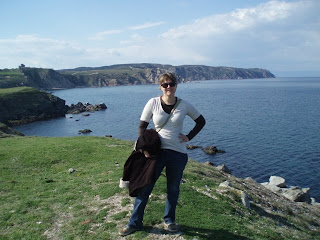I've known for a few months that I would be coming to Turkey. Prior to my trip, I somehow, by complete chance, ended up reading two novels that took place in Istanbul at two different historical periods. The books also managed to have different levels of success both in the story-telling and in the recreation of the city (which John Camp has called the 'true center of the world').
I don't normally go for the historical fiction. I do history for a living, so I'm not really interested in reading about that kind of stuff for fun. But some friends highly recommended this book called
Sailing to Sarantium by Guy Gavriel Kay. It's set in Byzantine Constantinople under the rule of Justinian. It's historical fiction researched to the point that I could actually tell you what book the author got his research from but all the names are changed to spare the innocent: Justinian = Valerius, Procopius = Pertennius, and so on. Even the title 'Sailing to Sarantium' refers to WB Yeats 1927 poem 'Sailing to Byzantium' which is in turn referenced in Colin Wells'
Sailing from Byzantium: How a Lost Empire Shaped the World. I have to admit, though, that I did enjoy the book, but found its sequel to be far superior in every way.
What I liked about
Lord of Emperors is that the main characters were 1) a mosaicist working in this building:
 Agia Sophia, the 6th c. church built by the Byzantine Emperor Justinian, later turned into a mosque.
Agia Sophia, the 6th c. church built by the Byzantine Emperor Justinian, later turned into a mosque.

The scaffolding reaching up to the tip-top dome gives a great idea of the conditions required for tiling a mosaic on such a huge dome. Apparently they are sprucing up Agia Sophia in preparation for Obama's impending visit.
2) a charioteer in the hippodrome and 3) a dancer for the Greens faction.

Terracotta figurine of a woman on a donkey/horse/thing, Istanbul Archaeological Museum.
It really did bring Constantinople to life, most vividly in its depictions of the chariot racing and the soccer hooliganism of the principle factions in the city, the
Blues and Greens. Really cool stuff.
GGK convinced me that the chariot races could be a lot more exciting then I thought. The
hippodrome has since been turned into a central avenue in the center of Istanbul, next to Agia Sophia and marked by two obelisks and the serpent column from Delphi, formerly lining its
spina (the median).
The plan of the ancient hippodrome still shapes the urban landscape.
Because the ground was not completely flat, a huge curved platform had to be constructed at one end of the hippodrome, still partly visible today.
So all in all, I enjoyed the novel, especially for its colorful and rich depiction of Constantinople.
The second novel I read before coming to Turkey was Juliet Marillier’s
Cybele’s Secret, the sequel to her YA
Wildwood Dancing. Set during the 14th/15th century, when Italian merchants flocked to Istanbul and the Golden Horn, it follows Marillier’s standard approach, the reinterpretation of folk-lore into a magical romance for SF girls.
Grave stele of Demetrios, Istanbul Archaeological Museum.
I have been known to enjoy some of her stories, what can I say. This one, however, did not work for me at all. Mostly the plot and characters left a lot to be desired, but I will admit that the novel generally does exhibit a snapshot of the historical city, complete with hamams (bath houses), libraries full of manuscripts, and foreign traders. While it was well-researched, the depiction of the city felt dry and analytical, it created a city without specific personality or heart. There was no sense that a city is both its structure and its people, and that together they have a unique stamp. Even though the hustle and exotic bustle of Istanbul was central to the story, the description read as any standard depiction of an ‘Eastern’ city, repeated in the fantasy genre a thousand times over. I didn’t ‘
get’ Istanbul the way I got GGK’s Constantanople/Sarantium.
But I was glad that I had read them both before going to Turkey and spending a few days in the heart of Byzantium. Visiting a town like Istanbul with its cityscape marked by domes, the alternating call-to-prayer of Agia Sophia and the Blue Mosque, and wooden Ottoman houses starred with colored tiles…well, it makes it hard to appreciate concrete, colorless Athens. The Acropolis seems all the more barren and lifeless having seen Justinian churches-turned-mosques and the Alexander Sarcophagus. (Mash is out there sharpening the knives, I can hear it as I type this.)

Wondering how to get into a locked mosque, also known as one of the three surviving churches from the reign of Justinian.
But on the other hand, it’s fantastic to get out of Turkey. Sorry Hüseyin, but Turkey is sometimes not a fun place to go as a foreign woman. It’s the kind of place where the experience is entirely different if you walk to the ATM alone or with a male chaperon, even in the tourist heart of the city. I won’t make that mistake again. I can't tell you what a relief it is to be back in a place where you can walk down the street alone - it's nice not to feel like you're on display for sale when strolling down the street. Yikes.
 All very pleasant on the surface. A square in Istanbul is adorned with election flags.
All very pleasant on the surface. A square in Istanbul is adorned with election flags.
Anyways. If you are looking for a SF glimpse of the city that ruled the world just as completely and eternally as old Rome did, go with GGK's
Sarantine Mosaic. It much more accurately captures the two-faced nature of Istanbul, but does so in a way that makes Constantinople/Sarantium a major and nuanced character in the book. Think the 'landscape' in the LOTR movies, and then some.















 I looked at a lot of polygonal masonry made in purple andecite. As John Camp has stressed, Aristotle declared that fortification walls should be an adornment to the city, and the walls of Larisa, with their attention to color and pattern, exemplify the idea well.
I looked at a lot of polygonal masonry made in purple andecite. As John Camp has stressed, Aristotle declared that fortification walls should be an adornment to the city, and the walls of Larisa, with their attention to color and pattern, exemplify the idea well.











 These crusty dudes were munching on some leafy goodness about 10 feet away from the krepidima (base) of the temple of Apollo at Didyma.
These crusty dudes were munching on some leafy goodness about 10 feet away from the krepidima (base) of the temple of Apollo at Didyma.
























